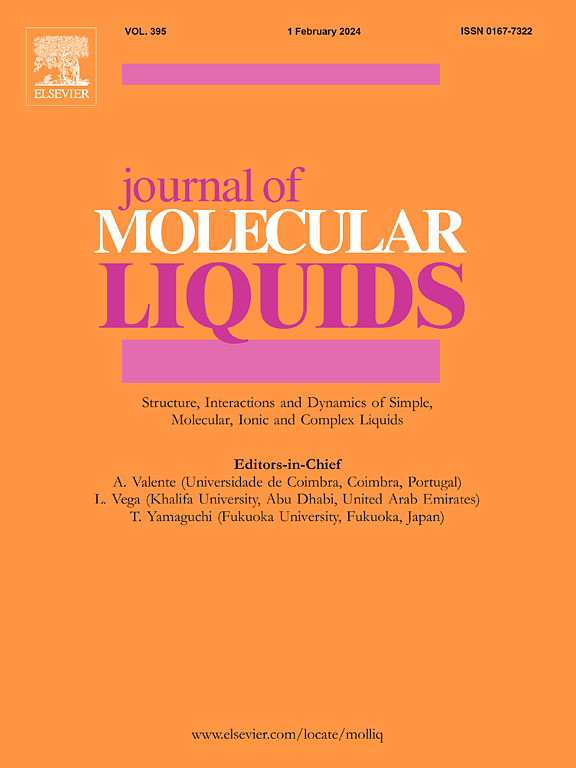Formaldehyde and water adsorption in MFI zeolite Channels: A molecular simulation study
IF 5.3
2区 化学
Q2 CHEMISTRY, PHYSICAL
引用次数: 0
Abstract
Formaldehyde (HCHO), a hazardous indoor air pollutant, presents significant challenges for efficient removal under humid conditions. This study employs configurational bias Monte Carlo (CBMC) simulations to explore the co-adsorption behavior of HCHO and H2O in all-silica ZSM-5 zeolites at ambient temperature and variable loadings. The results reveal a dual adsorption mechanism modulated by loading: At low loading, H2O molecules preferentially occupy zigzag channels due to strong hydrogen bonding, indirectly enhancing HCHO ordering in straight channels; At high loading, directional hydrogen bonding leads to the formation of HCHO-H2O chain-like molecular clusters that stabilize adsorption but hinder diffusion. A transition point, approximately 224 molecules per supercell, marks the shift in the adsorption mechanism. Radial distribution functions, isosteric heats, energy distribution curves, and isodensity maps collectively indicate that HCHO stacking follows a neighbor-crossing conformation, regardless of the presence of H2O. These findings provide molecular-level insight into competitive and cooperative adsorption in zeolites, offering guidance for the design of humidity-tolerant adsorbent materials.
MFI沸石通道中甲醛和水的吸附:分子模拟研究
甲醛(HCHO)是一种有害的室内空气污染物,在潮湿条件下有效去除甲醛是一项重大挑战。本研究采用构型偏压蒙特卡罗(CBMC)模拟研究了环境温度和不同负载下全硅ZSM-5沸石中HCHO和H2O的共吸附行为。结果揭示了负载调节的双重吸附机制:低负载时,由于氢键强,H2O分子优先占据之字形通道,间接增强了HCHO在直线通道上的有序性;在高负载下,定向氢键导致形成hho - h2o链状分子团簇,稳定吸附但阻碍扩散。一个过渡点,每个超级单体大约224个分子,标志着吸附机制的转变。径向分布函数、等等热、能量分布曲线和等密度图共同表明,无论H2O是否存在,HCHO的堆叠都遵循相邻交叉构象。这些发现为分子筛中的竞争和合作吸附提供了分子水平的见解,为耐湿吸附材料的设计提供了指导。
本文章由计算机程序翻译,如有差异,请以英文原文为准。
求助全文
约1分钟内获得全文
求助全文
来源期刊

Journal of Molecular Liquids
化学-物理:原子、分子和化学物理
CiteScore
10.30
自引率
16.70%
发文量
2597
审稿时长
78 days
期刊介绍:
The journal includes papers in the following areas:
– Simple organic liquids and mixtures
– Ionic liquids
– Surfactant solutions (including micelles and vesicles) and liquid interfaces
– Colloidal solutions and nanoparticles
– Thermotropic and lyotropic liquid crystals
– Ferrofluids
– Water, aqueous solutions and other hydrogen-bonded liquids
– Lubricants, polymer solutions and melts
– Molten metals and salts
– Phase transitions and critical phenomena in liquids and confined fluids
– Self assembly in complex liquids.– Biomolecules in solution
The emphasis is on the molecular (or microscopic) understanding of particular liquids or liquid systems, especially concerning structure, dynamics and intermolecular forces. The experimental techniques used may include:
– Conventional spectroscopy (mid-IR and far-IR, Raman, NMR, etc.)
– Non-linear optics and time resolved spectroscopy (psec, fsec, asec, ISRS, etc.)
– Light scattering (Rayleigh, Brillouin, PCS, etc.)
– Dielectric relaxation
– X-ray and neutron scattering and diffraction.
Experimental studies, computer simulations (MD or MC) and analytical theory will be considered for publication; papers just reporting experimental results that do not contribute to the understanding of the fundamentals of molecular and ionic liquids will not be accepted. Only papers of a non-routine nature and advancing the field will be considered for publication.
 求助内容:
求助内容: 应助结果提醒方式:
应助结果提醒方式:


